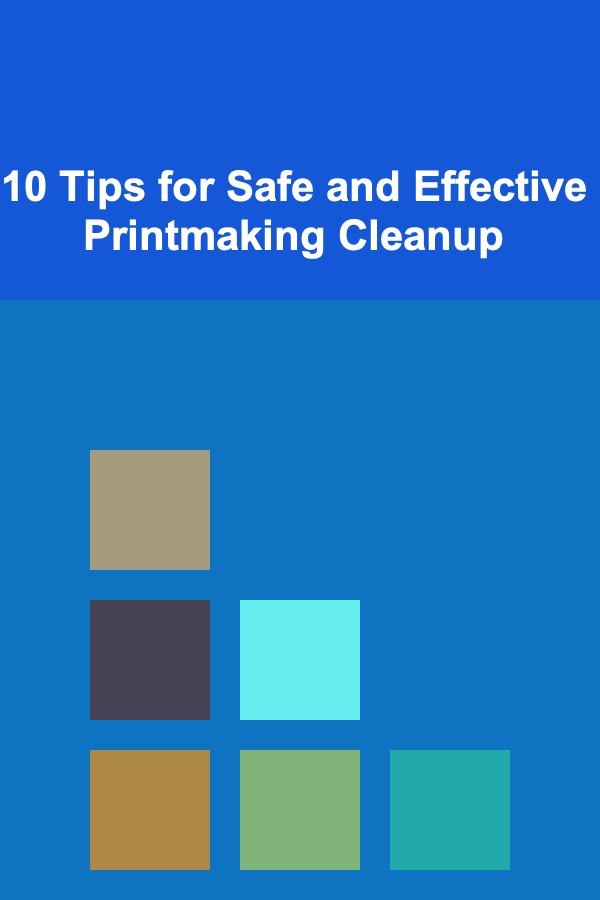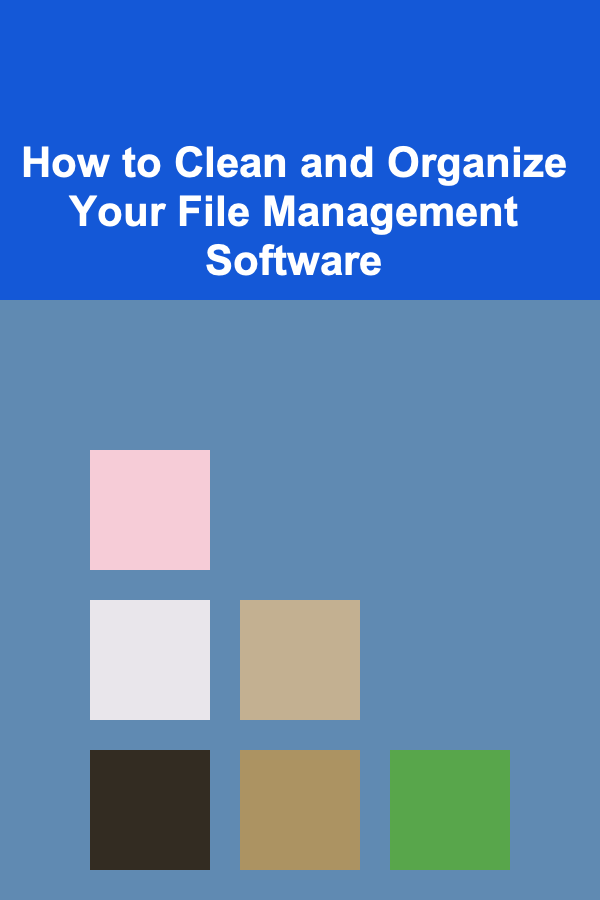
10 Tips for Safe and Effective Printmaking Cleanup
ebook include PDF & Audio bundle (Micro Guide)
$12.99$8.99
Limited Time Offer! Order within the next:

Printmaking, whether done at home or in a studio, is an exciting and creative process. However, it can also be a messy one. Ink, chemicals, and various tools are used during the creation of prints, which means that proper cleanup is essential to maintaining both a safe environment and high-quality work. Effective cleanup is critical not only for keeping your workspace neat and organized but also for preserving the longevity of your materials and tools.
This article provides ten essential tips for safely and efficiently cleaning up after printmaking sessions. These tips will ensure that your workspace remains safe, your materials last longer, and your prints continue to shine with the best quality possible.
Understand the Materials You Are Using
Before you even begin cleaning up, it's important to understand the materials you're working with. Printmaking involves a variety of inks, solvents, and chemicals, and each one may require a different cleanup process. There are many types of inks, including water-based, oil-based, and solvent-based, and they each have specific requirements for cleanup.
- Water-Based Inks: These inks are generally easier to clean as they can be washed away with soap and water. However, some may leave stains on surfaces, so it's best to act quickly.
- Oil-Based Inks: These require solvents, such as mineral spirits or turpentine, to clean up properly. They are more difficult to wash away, so thorough cleaning and proper disposal of the solvents are essential.
- Solvents: These chemicals are often used to clean ink rollers, brayers, and plates. However, they can be hazardous to health and the environment, so always be mindful of proper handling and disposal.
By understanding the specific requirements of the materials you use, you'll be able to choose the right tools and methods for cleanup and reduce unnecessary risks.
Wear Protective Gear
When cleaning up after printmaking, always wear appropriate protective gear. Some chemicals and solvents can be harmful to your skin, eyes, or respiratory system.
- Gloves: Wearing nitrile gloves is essential, especially when handling oil-based inks, solvents, and other potentially hazardous materials. Gloves protect your hands from chemicals, stains, and other substances.
- Safety Glasses: If you are using any strong chemicals, such as turpentine or other solvents, protect your eyes by wearing safety glasses or goggles.
- Respirators or Masks: If you're working with volatile chemicals that produce fumes, such as solvents and varnishes, consider wearing a respirator. Some fumes can be harmful to your health, so ensure that your workspace is well-ventilated, and take appropriate precautions.
Taking the time to protect yourself will help prevent injuries and keep you safe while cleaning up your printmaking supplies.
Use a Dedicated Workspace for Cleanup
One of the best ways to keep your printmaking materials and your home or studio safe is to designate a specific area for cleanup. This area should be well-ventilated and equipped with all the necessary tools to ensure effective cleaning.
- Work Surface: Choose a work surface that is easy to clean and can handle ink and solvent spills. Many artists use large sheets of glass, metal, or plastic as their work surfaces because these materials are non-porous and easy to wipe clean.
- Containment Area: Ensure that there is a contained area for cleaning supplies, such as a small basin or tray, where you can submerge tools like rollers and brayers. This prevents solvents from spilling onto other surfaces.
By establishing a dedicated cleanup area, you can reduce mess and the risk of contaminating other spaces.
Clean Tools Immediately After Use
To ensure that your printmaking tools last and remain in good condition, it is essential to clean them immediately after use. Ink that is left to dry on tools can become difficult to remove, and solvents or cleaning materials left on surfaces for too long may damage them.
- Brayers and Rollers: Clean rollers and brayers as soon as you're finished printing. Use a solvent appropriate for the type of ink used. If you're working with water-based ink, wash them with water and mild soap.
- Ink Plates and Trays: If you've used an ink plate or tray, scrape off any excess ink and wipe it down immediately. For stubborn ink, you may need to use a solvent for oil-based inks.
- Printing Presses: Clean your printing press after every use. Inks can build up on rollers, beds, and plates. Wipe down all surfaces with a solvent or appropriate cleaning solution and keep moving parts lubricated to prevent rust.
By cleaning your tools right after use, you'll prevent buildup and ensure that your equipment is in top condition for the next printmaking session.
Dispose of Materials Properly
Disposing of printmaking materials such as inks, solvents, and chemicals requires attention to safety and environmental responsibility. These materials can be hazardous to the environment if not disposed of correctly.
- Inks: Many inks are made from pigments, oils, or resins, which should never be poured down the drain. Check local guidelines for disposal and consider using specialized disposal facilities that handle hazardous materials.
- Solvents: Solvents such as turpentine and mineral spirits are flammable and can be toxic. Store them in well-sealed containers and dispose of them at designated hazardous waste collection centers.
- Rags and Paper Towels: Rags or paper towels that have been used to clean up ink or solvents should be stored in a safe, fireproof container until they are fully dried. Spontaneous combustion is a risk with solvent-soaked rags, so always store them in a sealed metal container.
Responsible disposal protects both the environment and the safety of those around you.
Use Environmentally Friendly Inks and Solvents
To reduce your environmental impact, consider switching to environmentally friendly inks and solvents. While these materials may cost a bit more, they can be safer for you and the planet.
- Water-Based Inks: These inks are often less harmful than oil-based inks because they don't require solvents for cleanup. They are also less toxic and easier to dispose of.
- Eco-Friendly Solvents: There are a variety of eco-friendly solvents available on the market that are biodegradable and safer for the environment. Look for natural solvents or those made from renewable resources.
By using more sustainable materials, you not only help the environment but also create a safer studio space for yourself and others.
Organize Your Supplies for Easy Cleanup
A cluttered workspace can make cleanup more difficult and time-consuming. Organizing your printmaking supplies will make it easier to access the tools and materials you need while ensuring that you have an efficient and smooth cleanup process.
- Use Containers for Tools: Keep your brushes, rollers, and other tools in designated containers to avoid clutter. Label containers and drawers so you can easily find the supplies you need.
- Organize Solvents and Cleaning Products: Keep all solvents, cleaning products, and other chemicals in a well-ventilated, secure location. Use storage containers that are clearly marked and keep flammable products away from heat sources.
By keeping your supplies organized, you'll save time and reduce the chances of creating a bigger mess.
Maintain Your Work Area Regularly
Maintaining your printmaking work area between sessions is just as important as cleaning up after each session. Regular maintenance prevents the accumulation of ink stains, chemical spills, and other messes that can affect your work.
- Wipe Down Surfaces: At the end of each session, quickly wipe down any surfaces that were used during the printing process. This will keep your work area tidy and ready for the next session.
- Check for Chemical Spills: After each printmaking session, inspect the work area for any spilled ink or solvent. Even small spills can cause permanent damage to your workspace or pose a safety risk.
Routine maintenance of your work area keeps your environment safe, organized, and ready for future printmaking sessions.
Have a Cleanup Routine
Creating a systematic cleaning routine will help you stay on top of the process and avoid neglecting any part of it. Establish a list of cleanup tasks to perform after each session.
- Step 1: Remove excess ink from rollers, plates, and other tools.
- Step 2: Clean the tools using the appropriate solvents or cleaning agents.
- Step 3: Wipe down your work surface and any equipment used, such as the printing press.
- Step 4: Store or dispose of cleaning materials properly.
- Step 5: Check that all tools are in good condition and that no ink is left to dry or harden on them.
By following a regular routine, you ensure that nothing is overlooked and that you're maintaining a clean and safe environment for your next printmaking project.
Educate Yourself on Best Practices
Finally, it's important to continue educating yourself on the best practices for printmaking cleanup. As materials and techniques evolve, staying informed on the latest safety guidelines and cleanup methods will help you work more efficiently and safely.
- Read Safety Labels: Always read the safety labels on inks, solvents, and other materials to understand any potential hazards and proper handling procedures.
- Follow Local Regulations: Be aware of any local regulations regarding the disposal of hazardous materials and follow them closely to ensure compliance and safety.
- Take Workshops: Attend printmaking workshops or courses to learn more about effective cleanup techniques and other studio practices.
Ongoing education ensures that you remain well-prepared to handle the complexities of printmaking and cleanup.
Conclusion
Proper printmaking cleanup is an essential part of maintaining a safe, organized, and productive workspace. By following these 10 tips, you'll not only protect yourself and your tools but also preserve the quality of your work. Whether you're using traditional techniques or exploring newer methods, a commitment to safe and effective cleanup will contribute to your success as a printmaker.
Reading More From Our Other Websites
- [Star Gazing Tip 101] Seasonal Star Guides: What Kids Can Spot Each Month and How to Find Them
- [Home Rental Property 101] How to Handle Late Rent Payments from Tenants
- [Organization Tip 101] How to Choose Multi-Functional Furniture for Small Spaces
- [Soap Making Tip 101] Best Soap‑Making Workshops Tailored for Kids with Autism
- [Mindful Eating Tip 101] The Science Behind Mindful Eating: How Awareness Transforms Your Health
- [Home Family Activity 101] How to Plan the Perfect Family Game Night at Home
- [Organization Tip 101] DIY Drywall Patch: Quick Fixes for Common Wall Damage
- [Home Renovating 101] How to Pick the Perfect Bathroom Vanity Ideas for Small Spaces
- [Home Rental Property 101] How to Rent a Luxury Apartment: What to Expect and How to Afford It
- [Personal Finance Management 101] How to Create a Personal Budget That Actually Works

How to Clean and Organize Your File Management Software
Read More
How to Set Financial Goals and Actually Achieve Them
Read More
How to Store Sports Equipment Without Clutter
Read More
Monetizing AI: How to Earn Money by Creating Deep Learning Applications
Read More
Why You Should Regularly Rotate Toys for Child Engagement
Read More
How to Navigate IRB Submissions as a Clinical Research Coordinator
Read MoreOther Products

How to Clean and Organize Your File Management Software
Read More
How to Set Financial Goals and Actually Achieve Them
Read More
How to Store Sports Equipment Without Clutter
Read More
Monetizing AI: How to Earn Money by Creating Deep Learning Applications
Read More
Why You Should Regularly Rotate Toys for Child Engagement
Read More